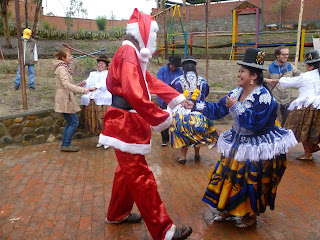Living and working in Bolivia has certainly
affected my health in ways that I wouldn’t have imagined. I was worried, as an
asthma-sufferer that I would have problems living at over 3000m altitude but I
have not experienced the slightest wheeze since I arrived! After 2 and a half
months I can still feel the oxygen lacking in the atmosphere on my lungs if I
walk up a steep incline or do any exercise but the ability of the body to
adjust to life at high altitudes is pretty amazing.
On the topic of food and digestion, I am
surprised how much my digestion was first affected by the altitude – digesting
a big meal took my body so much longer!
I am sure that all visitors to South
America can claim to at least one stomach upset or bout of
diarrhoea. This is usually caused by contaminated food or water and I am always
careful to avoid street food, salads and to drink boiled or bottled water.
Despite these precautions, I somehow managed to contract a particularly
resistant strain of Salmonella last week, lucky me!
Salmonella (a common cause of food poisoning)
does not normally cause serious illness. I had had some tests done the week
before due to constant stomach ache and had been sent away with loperamide (to
stop diarrhoea) and rehydration salts, awaiting one final test result. We had
plans to leave early for the weekend to visit the tropical cloud forests, North
of La Paz. Feeling absolutely fine I jumped on a bus to brave the white knuckle
ride down through the clouds...
...24 hours later, after a long, steep (very
beautiful!) hike in the humid cloud forests, in the heat of the sun, without
enough water, I was no longer feeling fine... In fact I’d never felt worse.
By the time I returned to La Paz on Sunday night
I was suffering with high fever, nausea and crippling stomach pains. My
feverish state continued all day on Monday until my very concerned team leader
suggested a visit to the clinic; this couldn’t have been better timing. I
couldn’t think straight, and my brain was struggling to comprehend the Spanish
being spoken by the nurses and doctors. All I know is that everyone repeated
“caliente, caliente” (meaning hot in Spanish) a lot, the lights were too
bright, I was whisked up in to a hospital room in a wheelchair and the next
thing I know, I’m being pumped full of drugs via a drip in my arm!
The next few days are a feverish blur in my memory,
of white sheets and walls, hallucinogenic dreams, syringes full of clear liquid
and the concerned faces of doctors and nurses. It turned out that the final
test result of last week that I had been waiting for, was positive for
Salmonella… This strain of salmonella was resistant to the first antibiotics
I’d been started on. So after changing the type of antibiotic, the fever
finally started to subside on Wednesday.
Despite this horrible ordeal, I was very well looked
after in the hospital by multiple doctors and nurses around the clock. I had a big
room with everything I could need. I also had lots of lovely visitors including
my team leaders, fellow volunteers, even my Spanish teacher and colleagues from
the zoo :). So, all things considered, my Bolivian hospital experience
was a good one! I was sent away with happy smiles from the nurses (probably
glad to see the back of me!), definitely a lot lighter (I couldn´t eat for 4
days) with a stack of medications to nurture my suffering organs, and of
course, a big medical bill (thankfully covered by my health insurance!).
.JPG)
.JPG)
.JPG)



.JPG)


.JPG)
.JPG)




















